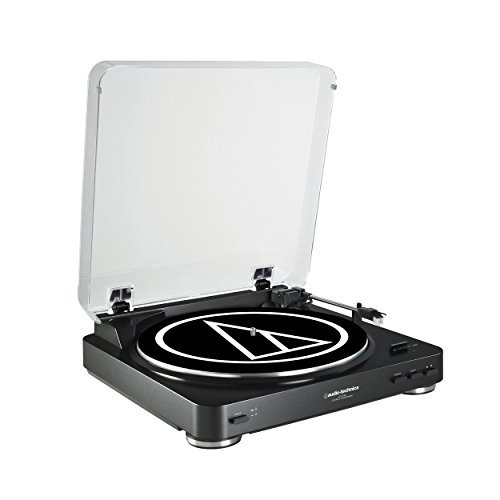





Integral Dual Magnet phono cartridge with replaceable diamond stylus
Color:Black | Style:Turntable Dynamic, balanced tonearm with soft damping control. Built-in user controlled pre-amp with RIAA filter. Selectable 33 and 45 rpm speed settings. Metal platter integrated cartridge. 14 3⁄16” W x 3 13⁄16” H x 14” D. Includes 45 RPM adapter, replaceable conical stylus, and RCA to mini-plug cable
This really is a nice table. I have listened to dozens of records on it since I bought it. However, there are two things you NEED to be aware of.1) The RCA plugs (red and white audio cables) that come out of the turn able are attached. There aren’t ports on the turn table, so you have to use the wires that are there already. Those wires are incredibly short. Like short short. Like MAYBE 3 feet short. So, if your turn table isn’t setup to be next to/on top of your receiver, it isn’t going to reach. You can go out and buy an adapter so you can add another set of RCA cables to lengthen the reach, but you’ll need to have the extra cables and the adapter. They’re not expensive or anything, but it is (I think) very poor design to need to do that.2) In my experience, the “stop” button regularly stops working. I contacted customer service (and Audio Technica customer service is AWESOME by the way) and was giving the directions on how to fix it. The issue is: When you push any of the buttons, it essentially pushes a rod that pushes a lever, that actually inputs the command. The problem is, the “rod” is the width of dental floss and gets easily pushed off of the lever. To fix this, you have to unhook the player, flip it over, take the bottom off and realign the rods. It’s easy to do, but having to pull the thing apart each time you want all of the buttons to work is pretty obnoxious.I’ll see if I can upload the photo tutorial “how to” that the customer service sent me so that everyone can have the directions to solve the problem.It plays nicely, and sounds good, and is a good price - but those two annoyances really get in the way for me. If not for those two things (or even just if not for the buttons getting disconnected) I’d call it 5 stars.
The only thing that could be better is a vintage one in good shape. The problem with vintage is that how does one really know it is in good shape without taking it home? The best you can hope for is to discern that it actually works. If you don’t have the time or money to gamble on vintage gear, go for this one.I have 3 other turntables, against which to compare it:1) Audio-Technica AT-LP120-USB. (from here on, I will refer to this as the ‘120’ and the AT-LP60 as the ‘60) This is a great turntable. It looks better, feels better, but I can’t say that I can tell the difference in sound it produces. Some of the things we pay extra for on that model are:a) Quartz timing control. This is something of value.b) 78 RPM speed, if you want the option of being able to play back the pre-1950 records. This is something of value.c) Manual pitch adjustment. I’m told some bad recordings had the speed off, so this is a way to manually correct it. I’ve got a couple hundred records, and have not yet found one that had the speed obviously off, so I can’t see any value in this.d) Reverse direction. I can’t see any value in this either. Some records have hidden messages if you play them backwards. Seems like something that might give a little thrill to hear it once or twice, but to pay extra for this ability? Nah, just go listen to those albums on YouTube to get your thrill.e) Electronic controls. These will probably hold up better many years down the road than the mechanical controls of the 60. No moving parts = fewer failure points.f) Counterbalanced tonearm. In theory, this is better, as we can adjust the stylus to ride heavily enough in the grooves to provide good sound, but not so heavy as to cause undue wear to the records. I’ve read elsewhere where someone measured the weight at the stylus and found this one to be 3 g. When I got the weight adjusted properly on my 120, it was 2.5 g. Not a notable difference, in the end.g) S-shaped tonearm. They say this is better, but I’ll be darned if I can hear the difference.h) Interchangeable headshell and cartridge. They say a change of cartridge makes a big difference in sound. Some people will spend hundreds of dollars on high-end cartridges to tailor the sound just to their liking. That seems silly to me. Why not just adjust the tone controls on one’s amplifier? Or get a proper EQ component. Anyway, I can admit there could be some value in this.i) USB out option. The 60 is available with this too, for an extra $20. It works great with the free Audacity software. I’ve ripped several LPs to .wav and .mp3. It’s worth paying extra for this feature, if only to make the records portable. But you don’t need to upgrade to the 120 to get it.j) Much heavier. The 120 has a big steel plate inside. I’m not sure what is up with this obsession for vibration dampening. There’s no discernable difference in sound as a result of all this damping. Any difference heard would be mostly down to the cartridge.k) LED strobe, to confirm at a glance that the RPM is correct.More comparison between the 60 and 120 later.2) Ion Vinyl Transport turntable. This uses the same mechanism as the ever-popular Crosley Cruiser, but adds battery operation, which I love. With the battery operation option, it is totally portable, not just portable in theory. I bring this to me to the Goodwill and other places for listening to used records. Gotta find out if those scratches are “skippers” before paying the full $1 and taking up room in my apartment for more junk. I bought this for sixty bucks at a local Half Price Books store, which also sells records. I just love this turntable, but it is not at all in the same league as this AT-LP60. It has a ceramic cartridge instead of magnetic. Sound quality is pretty terrible in this class of turntable. If you’re listening to a Crosley with this mechanism, you’re really missing out on how good vinyl can actually sound.3) Fisher-Price from 1978. I just gave this to my daughter for Christmas. Check feeBay, you’ll see the one. Believe it or not, this has a much better speaker than the Crosley/Ion/Jenson ones, and hence, better sound quality. But of course not comparable to this one, since it still has a ceramic cartridge. For techno-geeks, it has a really interesting drive mechanism though! (check YouTube for ‘how to repair a fisher-price turntable)Now if you’re looking at this turntable and you’re on a budget, you’re likely also looking at the 120 model, for over double the price. Having both of them now, I think this 60 is a much value. For the money, it gives just what one is after:1) Affordable2) HiFi-grade sound3) Not too big or heavy4) Semi-automatic operation. This is the key difference. It makes it very nearly as convenient to play a record as a CD, yet we still have the option to do it manually.The 60is about 40% smaller and 70% lighter than the 120, yet it functions just as well. It doesn’t take up as much room, and it isn’t a back-breaker to occasionally move around.The one con I’ve found so far about this turntable is that it comes with a felt slip mat. (same as on the 120) These are a disaster when it comes to static. I opened my 60 yesterday for Christmas, then re-packed it to bring home. I wasn’t careful enough in repacking, and I crunched up the edge of the slip mat, so now the records don’t spin flat. I pressed it underneath something heavy and flat last night, but it is still jacked up. I’ve got a couple cork ones inbound to replace these. That will address the static problem, as well as the crunched up problem.In short, the 120 is probably a much heavier-duty turntable. It will run hour after hour, year after year and keep going. No belts to break, no mechanics to break, nothing to really go wrong, except maybe electronic. But considering it is basically a copy of the famous DJ-favored Technics 1200, which was a mature design to begin with, that’s probably not even a concern.The 60 is a lighter-duty unit. It MIGHT wear out after 10 years of constant, heavy use. But its a lot more affordable, a lot more convenient, and a lot lighter and smaller. (though it can still operate fully with the dust cover down)
Just got one of these shipped all the way to Austria, was worried for a couple of days that the voltage and cycle frequency difference would be a problem, but it’s absolutely not so. In the meantime I exchanged emails with Audio Technica’s service center and support, and got a prompt reply that it’s a DC controlled unit, meaning that if it’s not a 120V current where you live, a simple voltage converter is sufficient.The sound just blew me away, I put the unit straight through a test of fire by running it into a professional audio interface with direct monitoring (no AD/DA conversion), and from that to a pair of active Genelec studio monitors. To top it all, I fed it “The Headhunters” by Herbie Hancock. All I can say is wow. Super clean, full sound from the preamp in the unit, very good signal to noise ratio (barely audible hissing and crackling between tracks, not really perceivable when there’s any kind of music going on). Let’s see if it runs this well over time, so far I’m very impressed. Five stars.BTW, if you check out the negative comments, some are talking about “how short the RCA cables are”, and some are talking about the unit’s “low volume”. That’s just audio ignorance running high around here. It comes with a pair of cables with which you can make an extension in two seconds, and the “low-volume” is because it comes with the pre-amp turned off. All you need to do to solve this “problem” is use your fingers to flip a switch in the back of the unit to “line” instead of phono. And if you complain that “assembling” the unit is difficult (putting three pieces together before running it), you’re just beyond hope.
As simple as it seems to use, the product didnt work. Tried countless troubleshooting methods. Pity.
Seems pretty decent, but I feel like I need to be very, very delicate using it, lest I break one of the flimsy little parts - a real contrast with the 50 lbs Thorens I just had to…
I got this product not too long ago and it worked great but it is already broken!!!
I hadn’t had a turntable for many years, but still had nearly a hundred albums/LPs in the closet. I respected the AT brand years ago, and liked the reviews I saw on this product.
Really happy with this turntable. Made a very good copy of an old LP to CD with little trouble using the provided Audacity SW. Quality of recording was great.
I can hardly begin to express how disappointed I was in this product and in the customer service I received from Audio Technica.
Great product. Thank you!
it premium machine
Amazing sound quality from a budget turntable. Very impressed.
comments powered by DisqusWe have had a lot of fun with this at a great cost